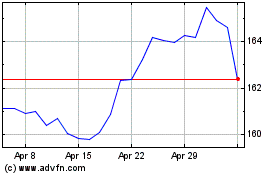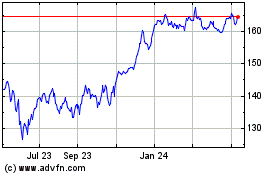T-Mobile's Top Engineer Took Risks to Develop 5G Network -- Journal Report
March 23 2021 - 4:42PM
Dow Jones News
By Drew FitzGerald
Before T-Mobile US Inc. executive Neville Ray began building 5G
networks, he first had to tackle color TV.
The British engineer earned some of his first paychecks more
than three decades ago by working on radio masts, oil rigs and
television-broadcast towers in the Middle East for a Dubai-based
contractor. Some areas in the region had only recently replaced
black-and-white TV broadcasts, while others were deploying
expensive digital mobile-phone service.
As a "young college kid looking for exciting stuff, looking for
travel, that was a great avenue for me to explore," the 58-year-old
Mr. Ray, president of technology at T-Mobile, says about his early
career. "So much was happening and was starting to happen."
The latest renovation project for Mr. Ray, who is responsible
for managing and developing T-Mobile's wireless network, is
prepping up to 85,000 cellular stations for equipment that can
carry 5G signals. It's an expensive, complex undertaking
complicated by the company's ongoing integration with former rival
Sprint.
That process demands careful planning so that existing customers
can keep using their existing phones while technicians install
equipment that supports newer 5G specifications.
T-Mobile has ambitious plans for its 5G service, including
eventually using it to serve devices such as connected cars,
factory machines and farm sensors. This month, the company launched
a new product called WFX Solutions that lets business customers
send workers a dedicated Wi-Fi hot spot backed by 4G and 5G
connections. The effort could help T-Mobile grow its relatively
small share of business customers by connecting homebound workers
over the air instead of through often-busy cable networks.
T-Mobile's 5G network benefits from a large cache of wireless
licenses spread across the radio spectrum, from low-frequency
airwaves suited for rural settings to ultrahigh-frequency
millimeter wave signals that are typically used in cities. Midrange
spectrum sandwiched in the middle gives the company a swath of
frequencies that balance high data speeds with geographic coverage.
Mr. Ray calls this stack a "layer cake" strategy.
Mr. Ray is relying on the usual suspects, as Nokia Corp. and
Ericsson AB, to supply much of the electronics for his network
upgrades. The carrier in 2018 signed two contracts totaling $7
billion to buy 5G equipment and services from the Scandinavian
suppliers, and it awarded them more business earlier this year.
T-Mobile representatives declined to share details about the annual
values of the contracts, which cover several years of upgrade
work.
"Obviously, it takes time to deploy those investments," Mr. Ray
says. Network upgrades demand constant adherence to tight
schedules, coupled with patience for the fruits of those efforts,
he adds.
Mr. Ray's work for his current employer started in 2000 at
predecessor VoiceStream Wireless, a relatively small Seattle-area
company later bought by Germany's Deutsche Telekom AG and renamed
T-Mobile. The carrier spent much of the following two decades
beefing up its infrastructure and expanding wireless coverage in
rural and suburban areas where more established rivals started with
a firstcomer's advantage.
"I'd like to think we only took smart risks, but we took risks,"
Mr. Ray says, citing decisions to invest in technology and wireless
frequencies that took years to deliver results. "In wireless, it's
fierce. You have to stay on your toes and you can never be
complacent."
Mr. FitzGerald is a reporter for The Wall Street Journal in
Washington, D.C. Email him at andrew.fitzgerald@wsj.com.
(END) Dow Jones Newswires
March 23, 2021 16:27 ET (20:27 GMT)
Copyright (c) 2021 Dow Jones & Company, Inc.
T Mobile US (NASDAQ:TMUS)
Historical Stock Chart
From Mar 2024 to Apr 2024

T Mobile US (NASDAQ:TMUS)
Historical Stock Chart
From Apr 2023 to Apr 2024
